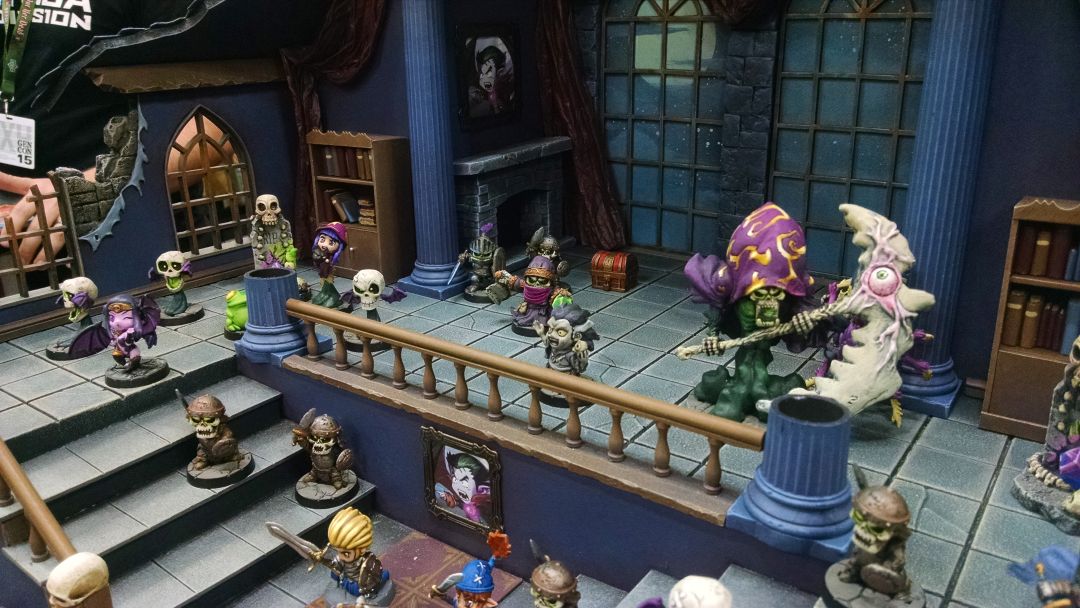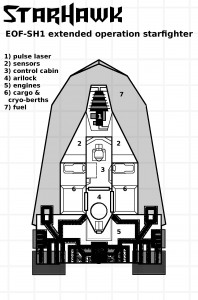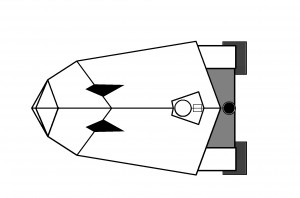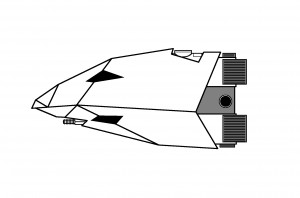See Through Time
It is the future you see. Or one future of many.
Grand Jedi Master Yoda
For use with Traveller, this new psionic power – temporovoyance – allows psions to see into possible futures.
In the distant past the psychic priests of Archeron, who pioneered the technique, referred to it as chronomancy. This power was then used in the Naikerran Empire, in an age when reliable star charts were not yet available, to establish a near-monopoly on interstellar travel. The Naikerran psion-navigators would glimpse into the future to see if their arrival would be safe before traveling through the warp.
Very rare in the Fifth Interstellar Empire of Humanity, tempovoyance is forbidden by Emperor Omerox, along with all other unregistered psychic powers.
This power presents an opportunity for players to contribute to the story. By describing a possible future, the psion’s player presents the GM with ideas to use in the game. The GM is encouraged to collaborate with the player using the “yes, and…” dynamic, molding the story idea into something dramatic and fun.
Powers
Glimpse – on successful psionic (temporvoyance) roll, the player gets a sense of what’s about to happen in the next few moments. This lets them modify an upcoming roll per the rules on chain tasks. Of course there is danger in looking into possible futures – a bad psion roll can result in a penalty to the task.
Temporvoyance, Psionic Strength, 10–60 seconds, Average (+0).
Costs 1+Range.
Vision – gives GMs and players a tool to allow players to contribute to the game’s story. On a successful psionic (temporvoyance) roll, the player has a vision of the future. Perhaps it’s a future that the psion wants, maybe it’s a scenario they want to avoid. Players are encouraged to describe what they see. The GM has discretion to use or modify the possible future glimpsed. The vision might include things to try to do or avoid to bring that possible future about.
Difficulty and cost should be determined by the GM based on the scope and reach of the vision.
Temporvoyance, Psionic Strength, 10–60 minutes, Average to Difficult (+0 to -4).
Costs GM’s discretion.
Feedback
This power is a work in progress – what other uses could it have? What do you think of the idea?
Let us know in the comments below!
Posted in Traveller by Adam A. Thompson with no comments yet.
GenCon 2015 – Costumes, Miniatures and Custom Terrain
Now that I’ve covered the phenomenon of crowdfunding and the changes to the tabletop game marketplace evidenced at GenCon 2015, I’d like to move on to the eye candy.
There were a tremendous number of great costumes this year. There were also quite a lot of impressive miniatures and pieces of terrain. I snapped some pictures of everyone’s wonderful hand-made art over the weekend as I wandered the convention. Here are a couple of my favorites.
Miniatures
There were lots of jaw-dropping paint jobs. The painting contest cabinet, in particular, was breathtaking.
Posted in convention and tagged GenCon2015 by Adam A. Thompson with no comments yet.
GenCon 2015 – So Many New Games
Kickstarter’s enormous utility has transformed the marketplace for tabletop games, causing an explosion of new games at GenCon
My number one impression from GenCon 2015 was, “Wow, look at all of these games I’ve never heard of!” In all my years of going to GenCon, generally only a handful of publishers were demonstrating wholly new products. This year I saw an unprecedented flood of new games. It seemed like every game I had ever heard of had a new card game, a new board game, and a new miniatures battle game based upon it. And there were dozens of entirely new games. Unsuprisingly, many of the banners said Kickstarter somewhere on them.
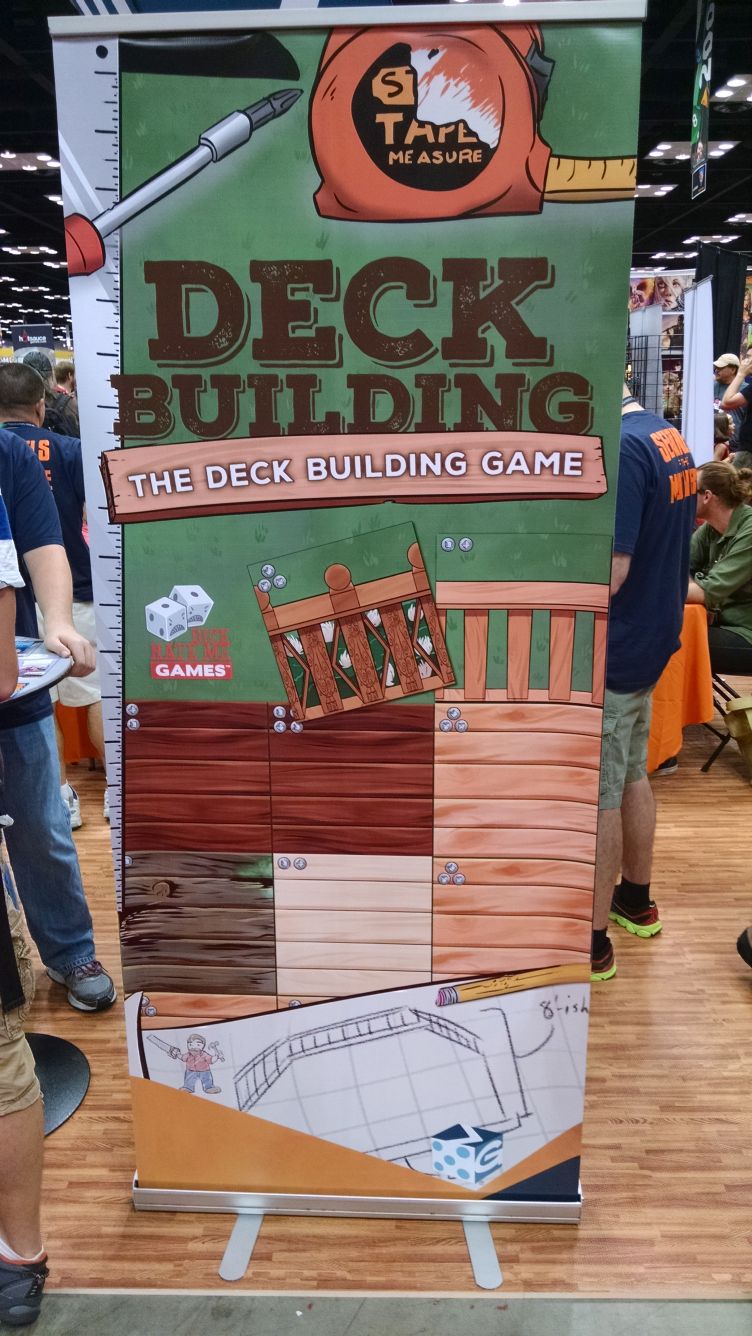
Yes, this is a game where players play to assemble a deck of cards and then use those cards to play a game where they build an in-game wooden deck. I know I may sound angry about this, but I also admire the courage it takes to spend money and make a game based on a pun. Bonus points for the clear graphic design – I got the joke right away.
To me all the new games demonstrate the transformative power of Kickstarter on the tabletop game market. Tabletop players are a lucrative demographic for crowdfunding solutions like Kickstarter – they have disposable income and are comfortable spending money on the internet. It’s also fun to see corporate juggernauts like Hasbro get cut off at the pass, economically speaking.
With all of that said, I’ll cede the stage to the slideshow. Further thoughts on the show can be read below and in upcoming posts about GenCon 2015. (more…)
Posted in convention, Editorial, news and tagged GenCon by Adam A. Thompson with no comments yet.
Traveller Fair Use Policy
The Traveller game in all forms is owned by Far Future Enterprises. Copyright 1977 – 2008 Far Future Enterprises. Traveller is a registered trademark of Far Future Enterprises. Far Future permits web sites and fanzines for this game, provided it contains this notice, that Far Future is notified, and subject to a withdrawal of permission on 90 days notice. The contents of this site are for personal, non-commercial use only. Any use of Far Future Enterprises’s copyrighted material or trademarks anywhere on this web site and its files should not be viewed as a challenge to those copyrights or trademarks. In addition, any program/articles/file on this site cannot be republished or distributed without the consent of the author who contributed it.
Posted in legal policies, Traveller by Adam A. Thompson with no comments yet.
If Game of Thrones were Dungeons & Dragons – Sir Meow-ntain
After playing Dungeons & Dragons (D&D) for more than thirty years, I often interpret a film or book as though it were a group of people playing. Here’s my take on Game of Thrones as if it were a game of D&D that George R.R. Martin was Dungeon Mastering.
Don’t worry, I have some more of these memes on the way.
Sometimes when you’re playing D&D the Dungeon Master does something to a Player Character that the Player never wants to happen again. Sometimes players take a setback personally or badly. Resourceful players will often then try to take precautions against a reoccurrence of the unpleasantness. Having your character’s favorite thing destroyed or stolen often makes players furious, as just one example. It’s a natural reaction to a traumatic event.
In Game of Thrones, if Circe were a PC, her Player’s apparent reaction to being taken prisoner included getting a giant, golden-cat-helmed, Frankenstein-esque murdering machine who was sworn to destroy all her enemies.
Posted in Comic by Adam A. Thompson with no comments yet.
Vesuvius Heavy Combat Walker
These massive war machines, dubbed “assault mechs” by their designers, dominated the battlefield at the height of the stellar era. Their moniker came from the fact that these types of combat walkers were designed and used to spearhead ground assaults and to destroy or hold objectives. Few other ground units are as heavily armed and armored – these walkers are even able to face off against light starfighters.
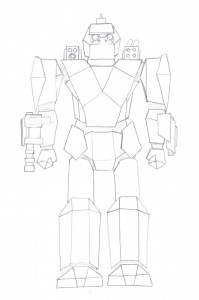 This combat walker is a TL 14 update of the fabled Galactic Monopoly (GM) Vesuvius-class assault mech with the latest in gauss, fusion and rocket weaponry. The anthropomorphic form, advanced fire control systems and neural control helmet allow humanoid pilots unparalleled reaction time and accuracy. It also carries the most armor of any combat walker design that saw widespread use.
This combat walker is a TL 14 update of the fabled Galactic Monopoly (GM) Vesuvius-class assault mech with the latest in gauss, fusion and rocket weaponry. The anthropomorphic form, advanced fire control systems and neural control helmet allow humanoid pilots unparalleled reaction time and accuracy. It also carries the most armor of any combat walker design that saw widespread use.
Vesuvius
Cost (Cr.) 31,705,700
TL 14
Skill drive (walker)
Agility 1
Speed 125 kph
Range 800 km
Crew 1 pilot
Cargo none
Open no
Hull 16
Structure 17
Armor 150 (225 front, 100 left and right, 75 rear, 100 top, 100 bottom) +13 (ERA)
Shipping Size 75 tons
Height 24 meters
Weapons
– hard point (right arm) – 22mm heavy gauss cannon (14d6 mega-AP, very distant range, 100 rounds), 19 spaces, 10,000,000 Cr
– hard point (left arm) – RF Plasma B Gun (14d6 destructive, distant range, auto 4) 16 spaces, 1,500,000 Cr
– missile bay (torso) – artillery rocket pod (16d6, distant range, auto 12, 30 rockets) 4 spaces, 52,000 Cr
– improved fire control (+4 DM) 100,000 Cr
Extras
– AFV
– manipulator arms (Str 24, Dex 16) 190,000 Cr
– laser anti-missile system (TL 13, +2 to negate hits, 2D6 damage), 4 spaces, 250,000 Cr
– explosive reactive armor type IV, 0 spaces, 125,000 Cr
– neural link (+2 initiative, +2 agility), 1,050,000 Cr
– advanced navigation (+3 DM), 50,000 Cr
– TL 10 communications (encrypted continental), 1 space, 8,000 Cr
– advanced electronic countermeasures (TL 14, +3 DM, ), 40,000 Cr
– advnaced sensors (TL 14, +2 DM, very distant range), 1 space, 62,500 Cr
– hostile environment protection, 1 space, 50,000 Cr
– life support (short-term, 1-4 days), 1 space, 20,000 Cr
– stealth (class III, +3 DM), 3,200,000 Cr
– smoke, 0.5 spaces, 1,000 Cr
– flares, 0.5 spaces, 1,200 Cr
– chaff, 0.5 spaces, 2,000 Cr
– prismatic aresol, 0.5 spaces, 4,000 Cr
– extra armor (superdense) x 15, 15,000,000 Cr
Posted in Traveller, Vehicle and tagged mech by Adam A. Thompson with no comments yet.
Regarding Characters – The Wounded
I liked Mad Max – Fury Road quite a lot. There’s been a bit of discussion about it, which I find refreshing. I’m really happy to have something to say about a major motion picture other than, “Wow, another wooden, formulaic, plodding Hollywood film.” Having seen it twice the thing that sticks with me is the detailed, understated writing. One place where you see this in the the characters. Furiosa, Max, and Immortal Joe all have interesting, well-developed characters.
Think about the journey that Max’s character makes – he goes from being a completely anti-social animal to reconnecting with people around him. It’s not a character journey you see male leads play very often in film. Hurt Locker was similar in some ways. Sometimes a child’s character goes through something similar, like Newt’s character in Aliens. It is a compelling and timely story. In an age of endless global war the archetype is both familiar and incomprehensible.
Here he is, a person brutalized by living at the edge of his wits for ?? years. Major damage. PTSD or ghosts. Loss. Betrayals. Whatever happened to all those kids that he escaped Barter Town with. After all that he’s in bad shape psychologically. Remind you of anyone? John Rambo? Your buddy who went off to war in central Asia and came back all fucked up? Yourself? Fury Road holds a mirror up to our faces, but it’s not a reflection that we see very much on the silver screen.
Conversely, the character many expect to see in Max is played by Furiosa. She is like Max’s character in the first movie – she sees that shit’s fucked up and she decides to take matters into her own hands. She conspires with the other women, steals a war machine, and makes a break for it. A warrior turned outlaw, according to the laws and traditions of Immortal Joe’s Citadel. She too has had years of trauma, but she is active, while Max is reactive. It’s a reversal of traditional gender rolls. Also, as a person with a prosthetic hand, Furiosa is another warrior who has been wounded.
It’s a role that seemed a bit odd to me when I first saw it, as I hardly ever see it portrayed. Or at least not by male characters. Is that what has some people complaining about this film? The fact that Mad Max’s character isn’t some heroic superman? To those who decry this movie, my question is, “Have you even been watching these films?”
As a fan of film I was interested by how Fury Road’s departure from the seemingly-omnipresent narrative played out. I liked it quite a lot. And it was totally metal. Five horns up.
\m/. \m/. \m/. \m/. \m/.
Posted in Editorial, Review by Adam A. Thompson with 1 comment.
Traveller NPC – The Black Ship’s Marines
These Traveller characters could be used in your game as thugs, criminals, or pirates in any part of the galaxy.
I’ll be using them in my game as the crew of the Lord Jukt’s black ship Dark Star, a notorious Fast Trader class pirate ship in the Skein Reach.
Careers: Rogue 2 (enforcer) – Henchman
Attributes: Strength 10 (+1), Dexterity 7 (+0), Endurance 9 (+1), Intelligence 6 (+0), Education 4 (-1), Social Standing 5 (-1)
Skills: athletics 0, deception 0, gun combat (any) 1, melee 1, recon 0, stealth 1, streetwise 1, (referee’s choice) 0
Armor: 15
Equipment: improved cloth armor, torso protector, light infantry helmet, firearm (pistol, carbine or rifle that matches the henchman’s gun combat skill and mission), hand weapon (knife, stunstick, arc-field claw, &ct.), 1,500 credits
Posted in Character, Traveller and tagged NPC by Adam A. Thompson with no comments yet.
EOF-HK1 Starhawk Extended Operations Fighter
30 tons – 25.3854 MCr.
Designed by the Empire to be carried by WPR-4F-ER warp boost rings, Starhawks can travel four parsecs at a jump. Because of this they are used extensively as armored couriers, forward scouts, or to transport small teams of agents. Some Imperial carrier fleets will scout nearby parsecs with patrols of these ships. They also serve well as ground attack fighters. Their versatility and the inclusion of a tiny galley and fresher in the cabin led to the HK1 gaining the nickname Kitchen Sink, as in “I’m on kitchen sink duty this week scouting the next sector.”
The three ton crystaliron armored hull acts as a lift body, making the Starhawk a flying wing with excellent atmospheric performance. Built tough, they can generally survive anything short of particle beam fire. Under the armor the four ton hydrogen fuel tanks provide a secondary layer of protection for the central cabin. This heavy frontal armor profile excludes a canopy or windows – instead views from sensors on the hull are presented to the pilot in a holographic display that integrates telemetry and targeting data.
As extended-operations fighters Starhawks feature extras that allow the pilot some comfort during missions. Instead of a cramped cockpit the fighter is piloted from a control cabin. If necessary, a humanoid can turn off the artificial gravity and sleep in the small fresher, per standard Imperial patrol procedure on these craft. There are also two cold berths for transporting passengers, extra crew, or for the pilot’s use during long flights. These cryo-berths can be set to automatically wake the occupants at a set time or as the ship is coming out of warp. There is also cargo capacity for three tons. The cargo spaces are equipped with small seats that fold into the walls, allowing the Starhawk to transport a small fire team.
They are also equipped with a repair or astromech droid, providing in-space repair ability and/or a robotic co-pilot. These can be replaced by a drone but the onboard computer does not usually have the capacity to run a repair program, leaving the pilot to operate the repair drone.
Other extras include probe drones and an airlock, giving them capability to perform search, rescue and repair operations. Often patrol duty will involve picking up or dropping off probe droids to be retrieved by the next patrol.
Starhawks are a TL 12 standard design subject to the %10 cost discount.
System – Details – Tons – Cost (MCr)
Hull – 0 points, streamlined – 30 tons – 1.43 MCr.
Structure – 1 points
Armour – 8 points crystaliron – 3 tons – 0.286 MCr.
Power Plant – class sM – 5.1 tons – 9 MCr.
Maneuver Drive – thrust 8 – class sM – 7 tons – 14 MCr.
Control Cabin – 3 tons – 0.15 MCr.
Crew – 1 pilot
Computer – model 1 – rating 5 – 0.03 MCr.
Software – fire control 1, library – 2 MCr.
Electronics – basic civilian: radar, lidar – 1 ton – 0.05 MCr.
Weapons – fixed mount TL10 pulse laser (long range, accurate, high yield) – 1 ton – 0.6 MCr.
Fuel – 4 weeks of operations – 4 tons
Cargo Capacity – 3 tons
Extras – airlock – 1 ton – 0.2 MCr.
– repair drone (1) – 0.3 tons – 0.06 MCr.
– probe drones (3) – 0.6 tons – 0.3 MCr.
– low berth (2) – 1 ton – 0.1 MCr.
Maintenance Cost (monthly) – 2,115 Cr.
Life Support Cost (monthly) – 200 Cr.
Posted in Starship, Traveller by Adam A. Thompson with no comments yet.
Warp Boost Rings
“Interstellar travel, kid. Some call it jumping, or warp, lightspeed, FTL, hyperspace, whatever. If you want to get out of this system, you need a ship that can do it. Like mine.” – Captain Liv Thunson, USS Sabre Tiger
Designed to give jump capabilities to smaller ships, warp boost rings are spacecraft that consist of a self-contained jump drive and fuel supply in a chassis that can dock with and carry a variety of small ships. Many designs use a ring-shaped chassis and interior docking clamps to accommodate a variety of ships under 60 tons, as long as they are small enough to fit inside the ring. Other designs use a sled-like chassis that the smaller ship sits atop.
As the jump ring hulls do not have maneuver drives of their own they rely on the thrust of the attached small ship for sub-lightspeed travel. Thrust will need to be recalculated according to the combined ships’ new tonnage and the maneuver thrust rating of the small ship. For example, a 50 ton modular cutter with thrust 4 docked with a WPR-A-2 are 90 tons combined and move at thrust 2. Because for most small ships half speed is the result, a handy way to determine the new thrust quickly is to simply halve the ship’s thrust while docked.
Due to poor aerodynamic characteristics these hulls give the docked ship -1 DM on pilot skill checks when in atmosphere. For this reason these rings are typically left parked at orbital refueling stations if the docked ship heads into atmosphere. They are nevertheless equipped with landing gear.
WPR-A-2 Warp Boost Ring – 100 tons – 19.044 MCr.
A common sight in the interior of the Imperium, the WPR-A3 allows small spaceships of up to 60 tons to dock and travel at warp 2. They often carry skiffs or boarding shuttles between systems.
When used to transport ships of 10 tons or less, their FTL range is extended to jump-3.
When carried on larger ships, these rings take up 40 tons of hangar space.
Monthly maintenance costs 1,587 Credits. Standard design (%10 discount).
100 ton hull – standard (ring) – 2 MCr.
Hull – 2 points
Structure – 2 points
Armor – none
Power Plant – A – 4 tons – 8 MCr.
Jump Drive – A – jump-2 – 10 tons – 10 MCr.
Fuel – one jump-2 and two weeks of operation – 22 tons
Computer – model 2 – rating 20 – 0.16 MCr.
Software – jump control 2 – 0.2 MCr.
Docking for small ship up to 60 tons – 4 tons – 0.8 MCr.
WPR-F-4 Warp Boost Ring – 100 tons – 39.51 MCr.
A longer-range version of the WPR-A-2, this chassis is mainly used to quickly move small ships such as modular skiffs or retrieval boats across the cosmos at warp 4. WPR-F-4 are frequently used to carry Starhawk extended range fighters.
When carried on larger ships, these rings take up 70 tons of hangar space.
Monthly maintenance costs 3,292 Credits. Standard design (%10 discount).
100 ton hull – standard (ring) – 2 MCr.
Hull – 2 points
Structure – 2 points
Armor – none
Power Plant – B – 7 tons – 16 MCr.
Jump Drive – B – jump-4 – 15 tons – 20 MCr.
Fuel – one jump-4 and two weeks of operation – 44 tons
Computer – model 4 – rating 20 – 5 MCr.
Software – jump control 4 – 0.4 MCr.
Docking for small ship up to 30 tons – 1 ton – 0.5 MCr.
Posted in Starship, Traveller by Adam A. Thompson with no comments yet.
